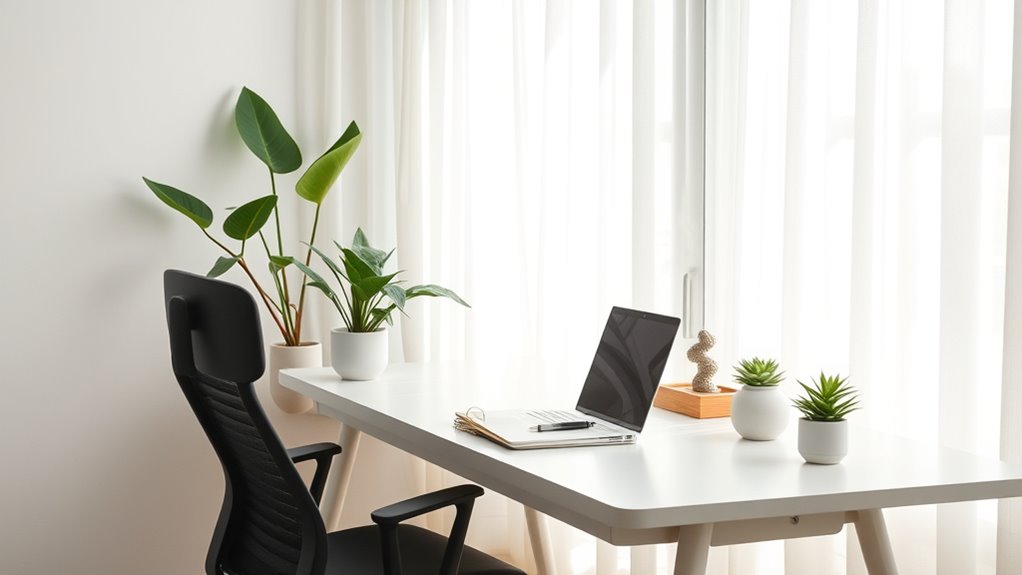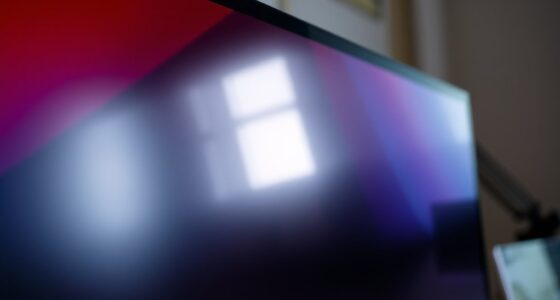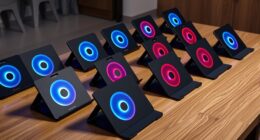To focus better in your home office, choose a quiet spot with plenty of natural light and minimal distractions. Keep your desk tidy by removing unnecessary items and using storage solutions. Control digital interruptions by silencing notifications and scheduling specific times for checking messages. Establish clear boundaries with household members, communicate your work hours, and set a visual schedule. Also, invest in ergonomic furniture for comfort. Keep exploring these tips to create an ideal workspace that helps you stay productive.
Key Takeaways
- Select a quiet, well-lit area near a window to boost focus and natural energy.
- Declutter your desk regularly, keeping only essential items within easy reach.
- Disable non-essential notifications and schedule specific times for checking emails and social media.
- Communicate work hours clearly to household members to minimize interruptions.
- Use ergonomic furniture and accessories to ensure comfort and maintain good posture during work.
Choosing the Right Location for Your Workspace
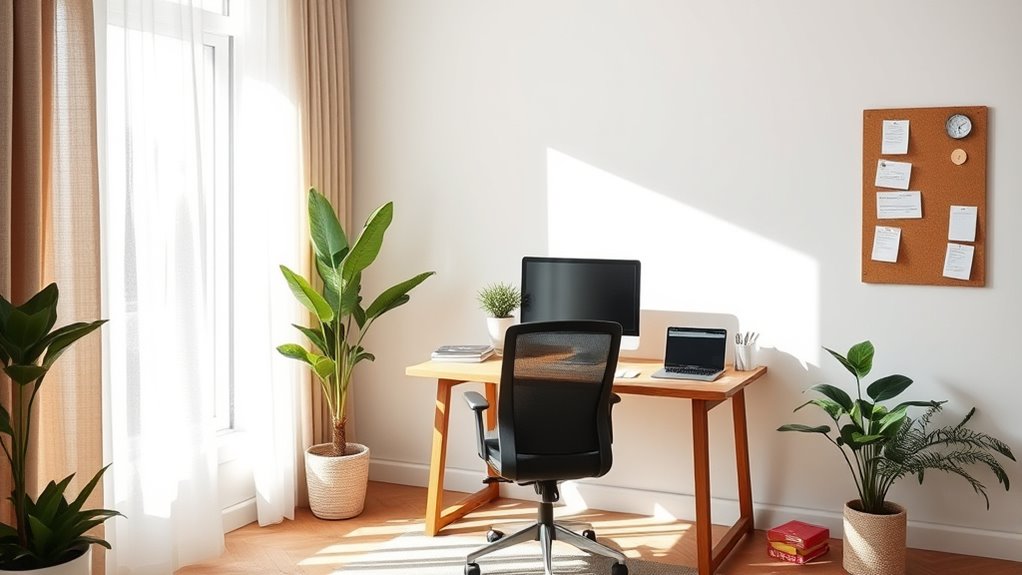
Finding the right location for your workspace is essential to staying focused and productive. Choose a spot with plenty of natural lighting to boost your mood and energy levels. Natural light reduces eye strain and helps keep you alert throughout the day. Also, consider noise reduction; pick a quiet area away from household distractions, like the kitchen or busy hallways. If your space isn’t naturally quiet, use soundproofing solutions or noise-canceling headphones to block out disturbances. Position your desk near a window if possible, so you benefit from sunlight. Avoid areas with high foot traffic or constant interruptions. A well-chosen location enhances your concentration, making it easier to stay engaged and efficient during work hours. Incorporating a calm, clutter-free environment can further improve your ability to concentrate.
Decluttering and Organizing Your Desk Area
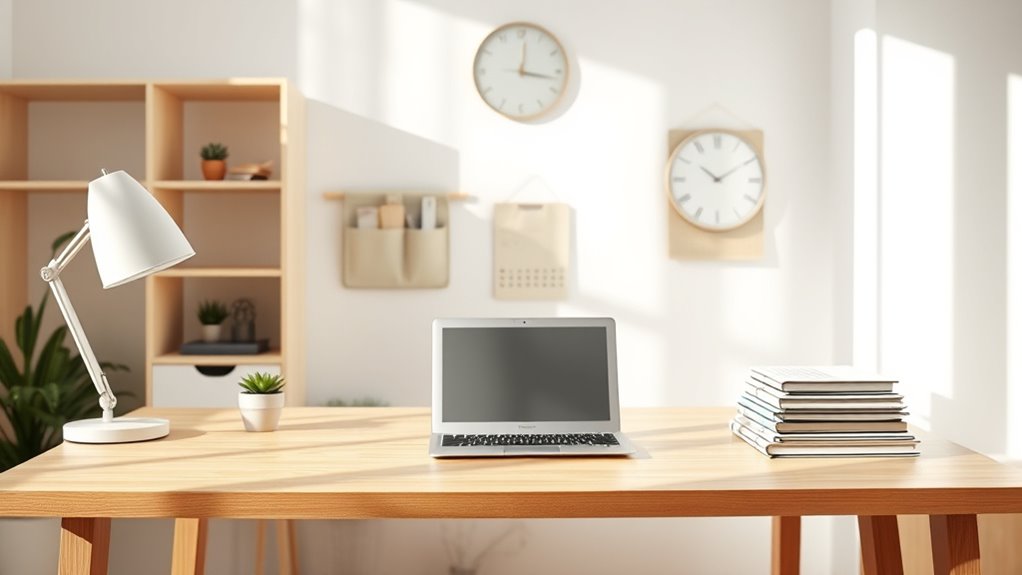
Once you’ve chosen a quiet, well-lit spot for your workspace, the next step is to keep your desk area tidy and organized. Start by removing clutter and only keeping essential items within reach. Use effective storage solutions like drawers, trays, or desktop organizers to keep supplies neat. Incorporate decorative accessories sparingly to add personality without causing distraction. Keep cords tidy with cable clips or wraps to prevent tangling. Regularly reassess your setup to eliminate unnecessary items. A clean, organized desk minimizes distractions and boosts focus, making your work sessions more productive. Incorporating organization methods can further enhance your workspace efficiency.
Implementing Effective Digital Distraction Controls
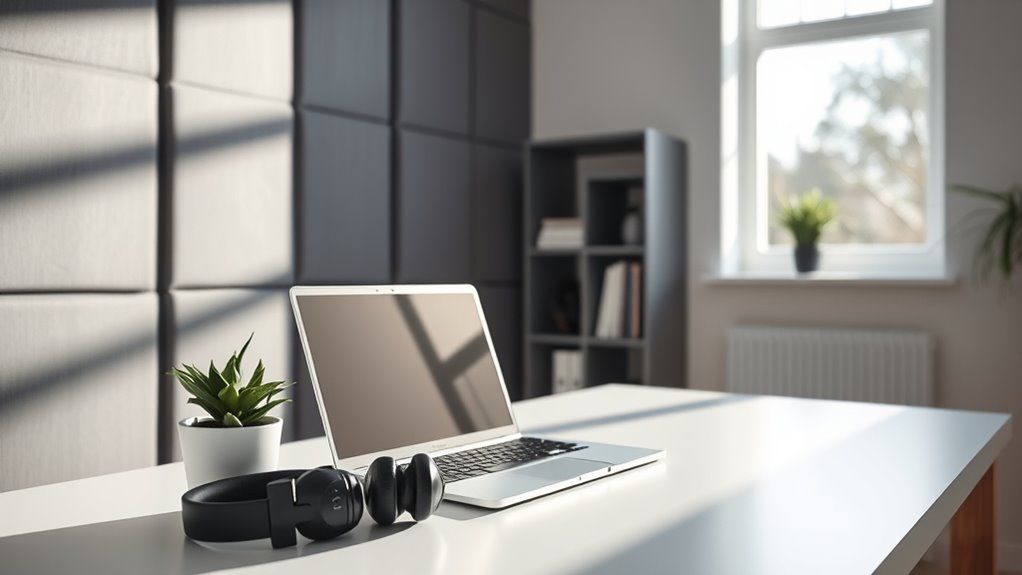
To stay focused in a digital world full of distractions, you need to take proactive steps to control your devices and notifications. Start with effective notification management by disabling non-essential alerts, so you’re not constantly interrupted. Use app blocking tools to restrict access to distracting apps during work hours, helping you stay on task. Additionally, consider setting specific times to check emails and social media, rather than responding instantly. Here are three key strategies:
- Turn off or silence non-urgent notifications.
- Use app blocking to limit access to distracting apps.
- Schedule designated times for checking emails and social media.
- Regularly review and update your categories for relevant content and tools that support your focus.
Implementing these controls keeps your focus sharp and prevents digital distractions from taking over your work.
Establishing Boundaries With Household Members
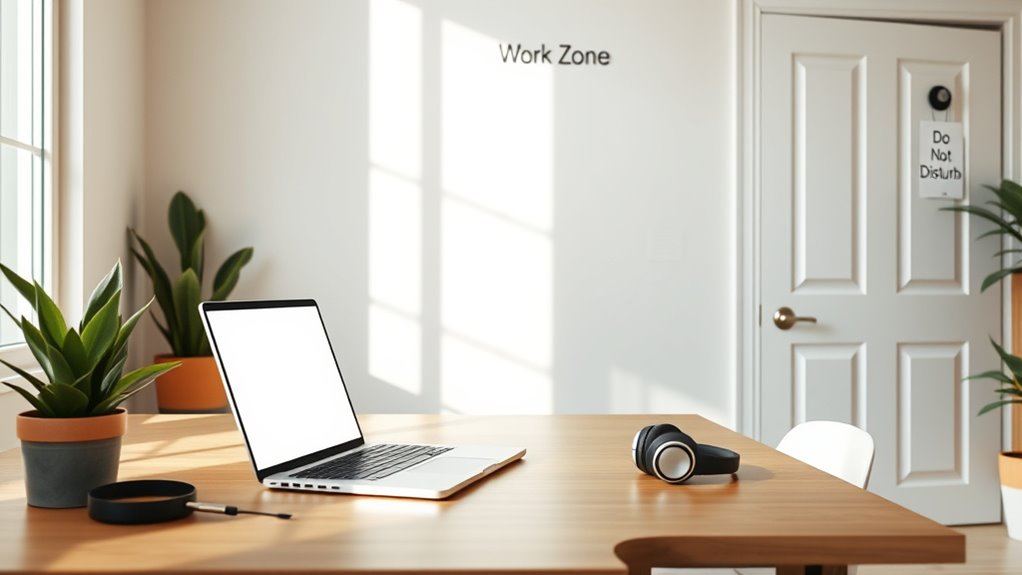
Establishing clear boundaries with household members is essential for maintaining your focus and productivity. Open family communication ensures everyone understands your work hours and limits interruptions. Setting scheduling boundaries helps prevent conflicts and clarifies when you’re unavailable. To facilitate this, consider creating a visual schedule that everyone can access. Additionally, understanding the importance of a high contrast ratio can help you choose the right setting for your workspace, ensuring optimal visual clarity and reducing eye strain.
Incorporating Ergonomic and Comfortable Furniture
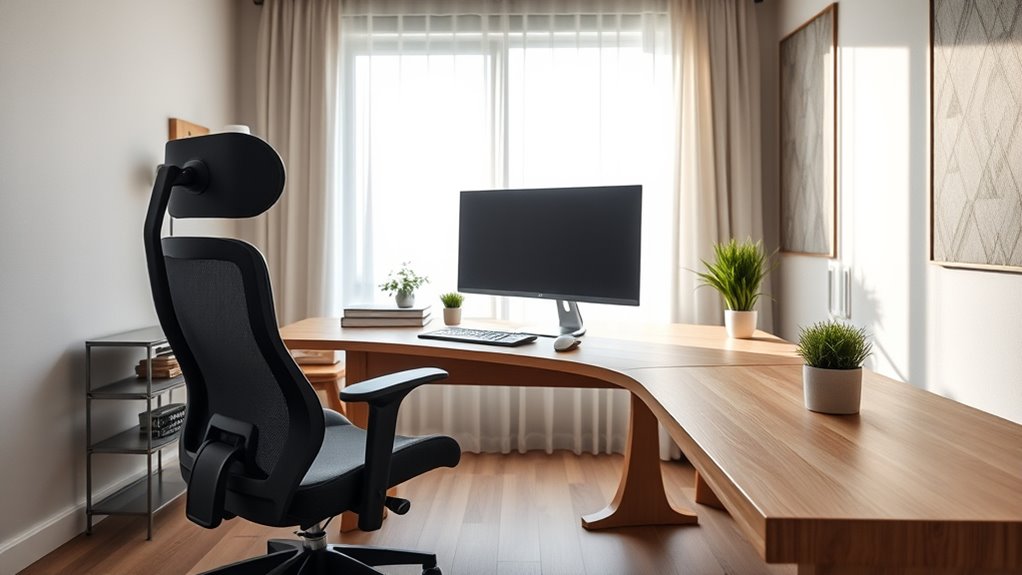
Creating defined boundaries at home helps you focus, but equally important is designing your workspace for comfort and efficiency. Investing in ergonomic accessories and comfortable seating reduces fatigue and boosts productivity. Here are three key tips:
- Choose an ergonomic chair that supports your back and promotes good posture.
- Use adjustable desks or surfaces to set a comfortable working height.
- Incorporate supportive accessories like wrist rests or footrests to minimize strain.
- Regularly taking breaks and practicing positive reinforcement techniques can improve your focus and overall well-being.
Using Visual and Auditory Cues to Stay Focused
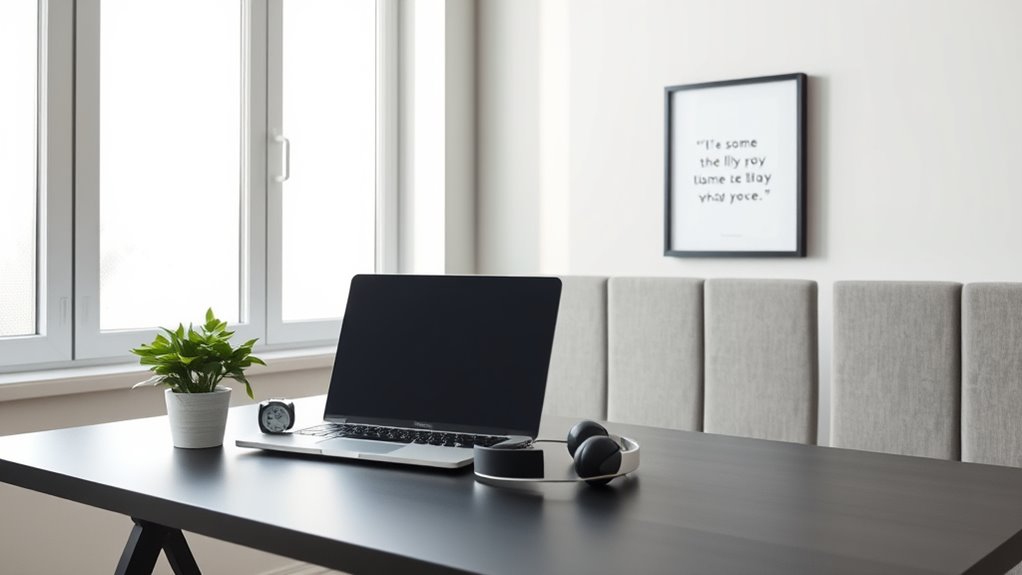
Using visual and auditory cues can considerably enhance your ability to stay focused by engaging your senses and providing clear signals to your brain. Visual cues, like a specific color scheme or organized workspace, help you immediately recognize when it’s time to work or take a break. You might also use visual timers or checklists to keep track of tasks. Auditory cues, such as background music or white noise, mask distracting sounds and create an environment conducive to concentration. Setting an alarm or using subtle sounds can signal when you should start or stop working, reinforcing your focus. Combining these cues simplifies your routine, making it easier to stay disciplined and maintain productivity throughout your work sessions. Incorporating digital literacy strategies can further support your focus by helping you manage online distractions effectively.
Maintaining Your Workspace for Long-Term Productivity

Building a well-organized workspace supports sustained focus by reducing distractions and making it easier to maintain routines. To keep your home office productive long-term, focus on three key areas:
- Declutter regularly to prevent distractions and foster clarity.
- Use ambient lighting to create a relaxing environment that minimizes eye strain.
- Incorporate decorative accessories thoughtfully, such as plants or artwork, to boost motivation without cluttering the space. Additionally, integrating celebrity interior design ideas can inspire stylish and functional decor that elevates your workspace ambiance.
Maintaining these elements helps you stay consistent and focused over time. Keep your workspace tidy, well-lit, and inviting with carefully chosen accessories. This environment encourages productivity, reduces stress, and keeps your motivation high for the long haul.
Frequently Asked Questions
How Can I Improve Focus During Unexpected Household Interruptions?
When unexpected household interruptions happen, you can improve focus by practicing mindfulness techniques like deep breathing or quick meditation to reset your attention. Using noise canceling solutions, such as headphones or white noise machines, helps block out distractions. Stay flexible and remind yourself that interruptions are normal. By combining mindfulness and noise control, you’ll find it easier to regain focus and stay productive despite surprises.
What Are the Best Tools for Tracking and Reducing Digital Distractions?
Imagine your focus as a garden that needs tending. Digital detox tools act like a fence, keeping distractions out, while focus apps serve as your watering can, helping you nurture concentration. Use apps like Forest or StayFocusd to block distracting sites, and schedule regular digital detoxes to clear mental clutter. These tools strengthen your focus, ensuring your productivity garden blooms without weeds of interruptions.
How Do I Create a Distraction-Free Workspace on a Limited Budget?
To create a distraction-free workspace on a budget, start with budget organization by setting a clear desk space and removing unnecessary clutter. Use DIY decor, like homemade cork boards or painted jars, to personalize your area without spending much. Incorporate simple solutions such as noise-canceling headphones or room dividers. These cost-effective tips help you stay focused and organized, boosting your productivity without breaking the bank.
What Strategies Help Maintain Focus During Long Work Sessions?
To stay focused during long work sessions, try incorporating mindfulness techniques like deep breathing or short breaks to reset your mind. Maintain an ergonomic setup with proper chair height and screen position to reduce fatigue. Minimize distractions by setting boundaries and using noise-canceling headphones if needed. These strategies help you stay alert, improve concentration, and make your work sessions more productive and comfortable.
How Can I Personalize My Home Office to Boost Motivation?
Personalizing your home office is like adding a splash of your favorite color to a blank canvas. You can boost motivation by choosing ergonomic furniture that supports your comfort and incorporating personalized decor that reflects your personality. Display inspiring photos, artwork, or meaningful objects. When your space feels uniquely yours, you’ll naturally feel more motivated and energized to work. Making it cozy and inspiring turns your office into a place you want to spend time in.
Conclusion
Creating a distraction-free home office boosts your focus and productivity. Imagine setting up your space in a quiet corner, decluttering your desk, and using headphones to block noise—suddenly, work feels more manageable. For example, Sarah dedicated a small nook for her office, set clear boundaries with her family, and saw her focus improve dramatically. With these simple steps, you’ll enjoy a more productive, stress-free work environment every day.
